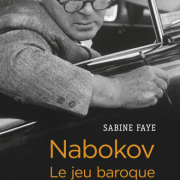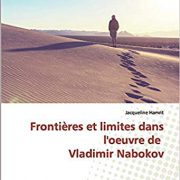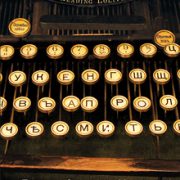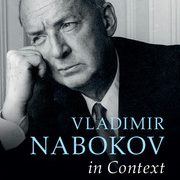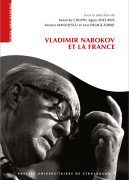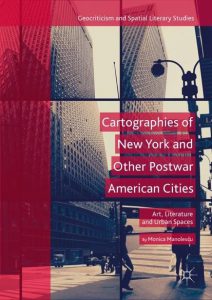
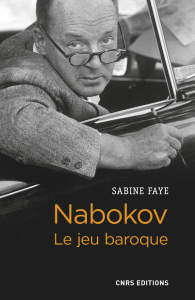
Vladimir Nabokov (1899-1977), l’auteur célèbre des romans Lolita et Ada, est un écrivain aux multiples facettes. Imprégné de culture classique, passant d’une langue à l’autre, d’un pays à l’autre, il se démarque de ses contemporains et crée une oeuvre jubilatoire qui joue avec les codes et les conventions littéraires.
Les habitudes de perception du lecteur sont constamment mises en question : une telle indétermination favorise les jeux d’illusions et les dédoublements caractéristiques de l’esthétique baroque. Le masque et le miroir sont les instruments privilégiés de cette écriture poétique.
C’est cet univers en perpétuelle métamorphose, où se mêlent mise en abyme du récit, rêves et trompe-l’oeil, qui nous est présenté en détail dans cet ouvrage.
Sabine Faye est maître de conférences au département d’anglais de l’université Paris III-Sorbonne Nouvelle où elle enseigne la littérature, la peinture et le cinéma anglo-américains.
Lien ici

Grâce à l’analyse de la conférence «The Art of Literature and Commonsense» conçue en 1941 et publiée à titre posthume en 1980, j’essaie d’identifier les caractéristiques de l’esthétique de Nabokov–fondée sur l’attention au détail et à l’émerveillement-, son éthique–marquée par l’importa
nce accordée à l’autre et la création de différences–et enfin sa métaphysique qui, contrairement à ce qu’affirment Richard Rorty et Vladimir Alexandrov croyant déceler la présence de platonisme et de transcendance dans sa philosophie, se caractérise par la contamination entre les oppositions que sont l’ici-bas et l’au-delà, la vie et la mort, ou la «réalité» et la fiction. La frontière qui sépare ces oppositions est, en effet, instable et fluctuante. J’étudie ensuite les préfaces «authentiques» jointes à Lolita, Bend Sinister, et Speak, Memory ainsi que les introductions écrites par Nabokov lors de la publication des traductions anglaises de ses romans russes à travers la problématique de l’Auteur, celle du genre et celle du temps. Je considère que Nabokov a utilisé les préfaces pour théoriser sur la littérature, prolonger son autobiographie et déconstruire l’opposition entre fiction et non-fiction.
Lien ici
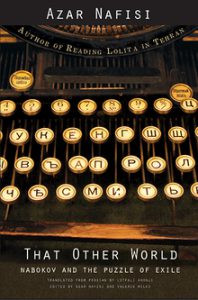 The foundational text for the acclaimed New York Times and international best seller Reading Lolita in Tehran
The foundational text for the acclaimed New York Times and international best seller Reading Lolita in Tehran
The ruler of a totalitarian state seeks validation from a former schoolmate, now the nation’s foremost thinker, in order to access a cultural cache alien to his regime. A literary critic provides commentary on an unfinished poem that both foretells the poet’s death and announces the critic’s secret identity as the king of a lost country. The greatest of Vladimir Nabokov’s enchanters—Humbert—is lost within the antithesis of a fairy story, in which Lolita does not hold the key to his past but rather imprisons him within the knowledge of his distance from that past.
In this precursor to her international best seller Reading Lolita in Tehran, Azar Nafisi deftly explores the worlds apparently lost to Nabokov’s characters, their portals of access to those worlds, and how other worlds hold a mirror to Nabokov’s experiences of physical, linguistic, and recollective exile. Written before Nafisi left the Islamic Republic of Iran, and now published in English for the first time and with a new introduction by the author, this book evokes the reader’s quintessential journey of discovery and reveals what caused Nabokov to distinctively shape and reshape that journey for the author.
Azar Nafisi has taught at the University of Tehran, the Free Islamic University, Allameh Tabatabi, and Johns Hopkins University’s School of Advanced International Studies. She is the author of Reading Lolita in Tehran: A Memoir in Books, as well as Things I’ve Been Silent About: Memories of a Prodigal Daughter and The Republic of Imagination: America in Three Books.
Link here
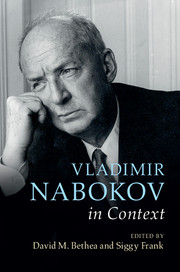
Le 30 novembre 2018, à l’Université de Rouen, Léopold Reigner a soutenu sa thèse de doctorat, intitulé « Le Flaubert de Nabokov : interprétation, continuité et originalité ».
Le jury était composé de Yannicke Chupin (Université de Cergy-Pontoise), Florence Godeau (Université Jean Moulin-Lyon III), Yvan Leclerc (Université de Rouen), Monica Manolescu (Université de Strasbourg), Isabelle Poulin (présidente, Université Bordeaux Montaigne), Anne-Laure Tissut (directrice, Université de Rouen).
Le 19 novembre 2018, à l’Université de Paris-Est Créteil, Agnès Edel-Roy a soutenu sa thèse de doctorat de littérature comparée, intitulée « Une “démocratie magique” : politique et littérature dans les romans de Vladimir Nabokov ».
Le jury était composé de Vincent Ferré (directeur, Université de Paris-Est Créteil), Luba Jurgenson (Université Paris-Sorbonne), Jean-Pierre Morel (président, Université Sorbonne Nouvelle-Paris 3), Isabelle Poulin (Université Bordeaux Montaigne) et Yolaine Parisot (Université de Paris-Est Créteil).


« In Nabokov and Indeterminacy, Priscilla Meyer shows how Vladimir Nabokov’s early novel The Real Life of Sebastian Knight illuminates his later work. Meyer first focuses on Sebastian Knight, exploring how Nabokov associates his characters with systems of subtextual references to Russian, British, and American literary and philosophical works. She then turns to Lolita and Pale Fire, applying these insights to show that these later novels clearly differentiate the characters through subtextual references, and that Sebastian Knight’s construction models that of Pale Fire.
Meyer argues that the dialogue Nabokov constructs among subtexts explores his central concern: the continued existence of the spirit beyond bodily death. She suggests that because Nabokov’s art was a quest for an unattainable knowledge of the otherworldly, knowledge which can never be conclusive, Nabokov’s novels are never closed in plot, theme, or resolution—they take as their hidden theme the unfinalizability that Bakhtin says characterizes all novels.
The conclusions of Nabokov’s novels demand a rereading, and each rereading yields a different novel. The reader can never get back to the same beginning, never attain a conclusion, and instead becomes an adept of Nabokov’s quest. Meyer emphasizes that, unlike much postmodern fiction, the contradictions created by Nabokov’s multiple paths do not imply that existence is constructed arbitrarily of pre-existing fragments, but rather that these fragments lead to an ever-deepening approach to the unknowable. »
Url de référence :
http://www.nupress.northwestern.edu/content/nabokov-and-indeterminacy
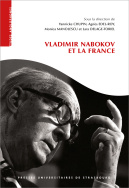 L’ouvrage Vladimir Nabokov et la France explore un espace de recherche vaste et peu balisé : l’invention de la France dans l’œuvre de Nabokov et l’étude interdisciplinaire de son héritage français. L’écrivain russo-américain a entretenu avec la langue et la culture françaises une relation riche et intense dont la complexité se dévoile dans ce volume, qui ouvre un nouveau champ dans les études nabokoviennes à la croisée de plusieurs disciplines (études américaines, comparées, françaises et slaves) et de plusieurs formations (linguistes, narratologues, philologues, traducteurs et artistes).
L’ouvrage Vladimir Nabokov et la France explore un espace de recherche vaste et peu balisé : l’invention de la France dans l’œuvre de Nabokov et l’étude interdisciplinaire de son héritage français. L’écrivain russo-américain a entretenu avec la langue et la culture françaises une relation riche et intense dont la complexité se dévoile dans ce volume, qui ouvre un nouveau champ dans les études nabokoviennes à la croisée de plusieurs disciplines (études américaines, comparées, françaises et slaves) et de plusieurs formations (linguistes, narratologues, philologues, traducteurs et artistes).Par-delà les considérations biographiques, cet ouvrage met en lumière la nature des liens à double sens entre la culture française et l’œuvre de l’écrivain, à savoir la place du cadre géographique et culturel de la France dans son œuvre, celle des écrivains et textes français, son usage de la langue française, sa relation à la pensée française, et enfin sa postérité dans le paysage littéraire et artistique français. De manière significative, le choix du bilinguisme pour les articles publiés ici vise à dépasser la division linguistique de la critique nabokovienne en s’adressant aux lecteurs tant anglophones que francophones et, de manière plus profonde, à penser Nabokov dans les deux langues.
Sommaire :
Preface – The Haunted Enchanter
Brian Boyd
Introduction
Yannicke Chupin, Agnès Edel-Roy, Monica Manolescu, Lara Delage-Toriel
I. L’Invention de la France et de l’Europe
Michael Wood – Do you mind cutting out the French? Nabokov’s disinvention of Europe;
Julian W. Connolly – Fluid Spaces, Illusive Identities: Nabokov’s Depiction of France in the Late 1930s.
II. Intertextes français
Susan Elizabeth Sweeney – Nabokov, Perrault, and Tales of Long Ago;
David Rampton – Allusions to French Literature in Nabokov’s Eugene Onegin: the Case of Voltaire;
Stanislav Shvabrin – Alfred de Musset, Vladimir Nabokov: The Invention of Exile;
Isabelle Poulin – Le vol de la mémoire. Vladimir Nabokov lecteur de Rimbaud et Mallarmé.
III. Langue française et modèles culturels français
Samuel Schuman – Monsieur Nabokov and Mademoiselle O;
Julie Loison-Charles – Les xénismes français dans Look at the Harlequins! : « ces clichés français sont-ils symptomatiques » ?;
Bénédicte Bintein – Le français, langue de la séduction fallacieuse dans l’œuvre de Vladimir Nabokov : une esthétique de l’ambiguïté;
Emily Eells – Proust, Nabokov and « the language of rainbows ».
IV. Nabokov et la pensée française
Leland de la Durantaye – Time in French, or Nabokov’s Mobile Image of Eternity;
Paul Grant – Blessing the Freak. Nabokov contra Bergson;
Lance Olsen – Not-Knowings: Debord’s Influence on Nabokov’s Real Life of Sebastian Knight.
V. Postérité de Nabokov et connivences contemporaines
Alisa Zhulina – Vladimir Nabokov and Alain Robbe-Grillet;
Alexia Gassin – Lolita, leitmotiv de l’œuvre de Serge Gainsbourg;
Anne-Marie Lafont – Apprendre autrement ou comment adapter Vladimir Nabokov au lycée.
Url de référence :
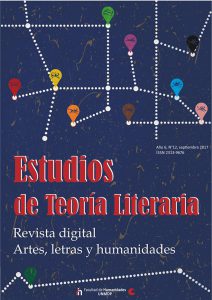
Los propósitos de este artículo son: i) analizar las relaciones de Vladimir Nabokov como autor multilingüe con la traducción al enfrentarse al exilio, y con la publicación de una de sus novelas en una lengua en que sabía escribir; ii) explorar las actitudes de Nabokov hacia la traducción en uno de sus libros, sus deseos de ser reconocido como autor y de pulir su estilo en la nueva lengua-cultura; iii) presentar factores como la identidad personal y cultural, y también las necesidades financieras de manera ligada al exilio y como elementos significativos en el proceso de traducción; iv) discutir el impacto de la reescritura en un autor alerta al reconocimiento internacional y en una búsqueda obvia de nuevos valores estéticos. Nabokov no es un caso único, pero su situación y sus reacciones son suficientemente representativas de las dificultades que surgen al escribir en una lengua ajena.
The aims of this article are: i) to analyze the relations of Vladimir Nabokov as a multilingual author with translation when faced with exile and with the publication of one of his novels in a language in which he could write; ii) to explore Nabokov’s attitude towards the translation of one of his books, his desires to be recognized as an author and to polish his style in the new culturelanguage; iii) to present factors like personal and cultural identity, and also financial needs as linked to exile and as significant elements in the translating process; iv) to discuss the impact of rewriting in an author seeking international recognition and in an obvious quest for new aesthetic values. Nabokov is not a unique case, but his situation and reactions are quite representative of the difficulties raised when changing one’s language of composition.
https://fh.mdp.edu.ar/revistas/index.php/etl/article/view/2331


